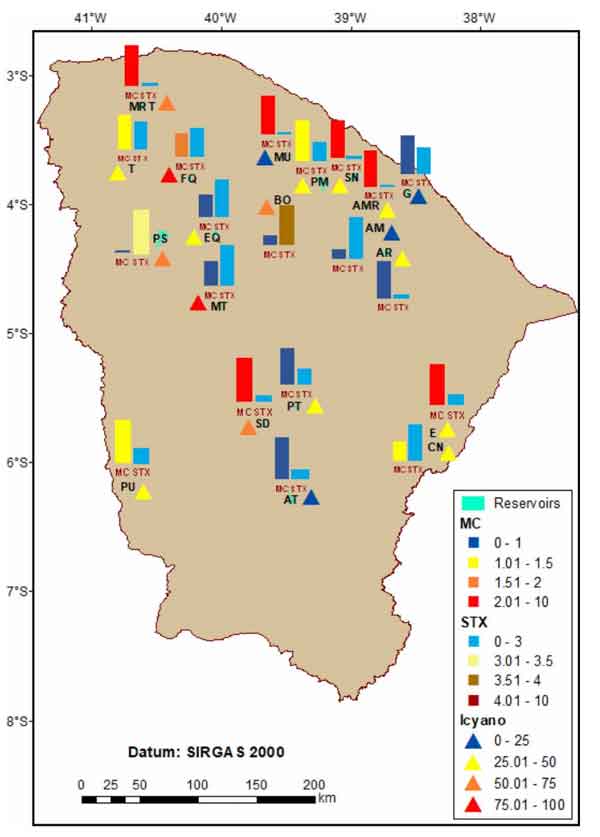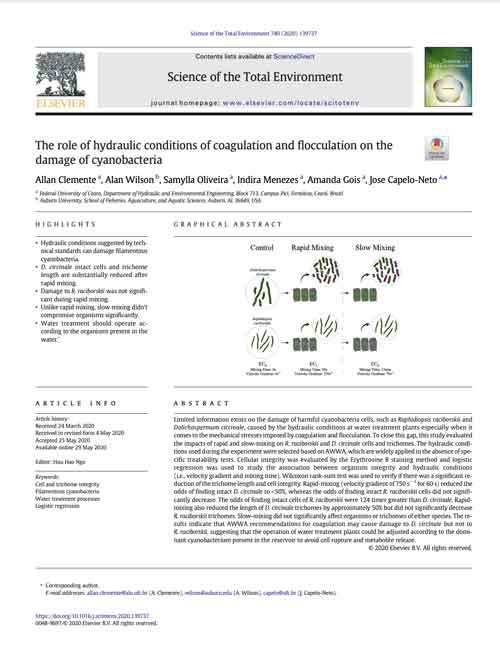Keyword: water treatment technologies

Barros, M. U.G., J. I.R. Leitão, T. R.B.T. Aranha, S. Simsek, R. P. Buley, E. G. Fernandez-Figueroa, M. F. Gladfelter, A. E. Wilson, and J. Capelo-Neto. 2020. Icyano: A cyanobacterial bloom vulnerability index for drinking water treatment plants. Water Supply 20(8):3517-3530.
Abstract
Managing freshwater systems has become a challenge for global water utilities given that cyanobacterial blooms have been increasing in frequency and intensity. Consequently, a water quality index that uses conventional measurements to assess toxic cyanobacterial hazards and guide the selection of proper treatment technologies could benefit water resource managers about water quality parameters routinely analyzed in line with environmental changes. An index model, called Icyano, showed that chlorophyll-a, cyanobacterial concentration, and total nitrogen were most important for the index. All reservoirs classified as good by Icyano used direct filtration water treatment technology. Many of the medium Icyano-classified reservoirs used a pre-treatment unit followed by a direct filtration unit. Two reservoirs that were classified as bad or very bad have been utilizing pre-treatment þ direct filtration or a complete cycle technology, respectively. As the Icyano index increases, water treatment plants should switch from direct filtration to using a pre-treatment to improve finished water quality. Findings from this project suggest that the direct filtration technology initially used in water treatment plants is not capable of meeting the current water quality guidelines in reservoirs that contain adverse water quality conditions, mostly related to an increase in toxic cyanobacterial blooms. As such, based on our findings, we recommend prioritizing financial resources towards pre-treatment technology or changes to more advanced technologies when Icyano index values increase.

Clemente, A., A. E. Wilson, S. Oliveira, I. Menezes, A. Gois, and J. Capelo-Neto. 2020. The role of hydraulic conditions of coagulation and flocculation on the damage of cyanobacteria. Science of the Total Environment 740:139737.
Abstract
Limited information exists on the damage of harmful cyanobacteria cells, such as Raphidiopsis raciborskii and Dolichospermum circinale, caused by the hydraulic conditions at water treatment plants especially when it comes to the mechanical stresses imposed by coagulation and flocculation. To close this gap, this study evaluated the impacts of rapid and slow-mixing on R. raciborskii and D. circinale cells and trichomes. The hydraulic conditions used during the experiment were selected based on AWWA, which are widely applied in the absence of specific treatability tests. Cellular integrity was evaluated by the Erythrosine B staining method and logistic regression was used to study the association between organism integrity and hydraulic conditions (i.e., velocity gradient and mixing time). Wilcoxon rank-sum test was used to verify if there was a significant reduction of the trichome length and cell integrity. Rapid-mixing (velocity gradient of 750 s−1 for 60 s) reduced the odds of finding intact D. circinale to <50%, whereas the odds of finding intact R. raciborskii cells did not significantly decrease. The odds of finding intact cells of R. raciborskii were 124 times greater than D. circinale. Rapid mixing also reduced the length of D. circinale trichomes by approximately 50% but did not significantly decrease R. raciborskii trichomes. Slow-mixing did not significantly affect organisms or trichomes of either species. The results indicate that AWWA recommendations for coagulation may cause damage to D. circinale but not to R. raciborskii, suggesting that the operation of water treatment plants could be adjusted according to the dominant cyanobacterium present in the reservoir to avoid cell rupture and metabolite release